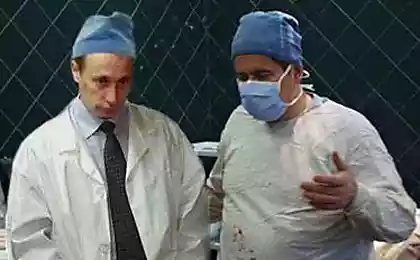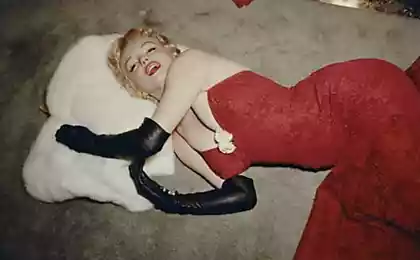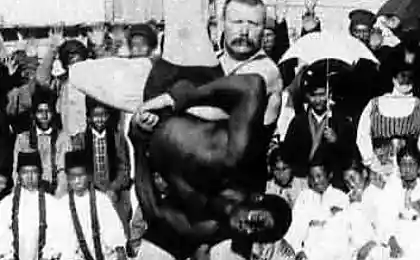867
Opening old crypts in Rostov-on-Don
At the end of the summer on the street Maxim Gorky began large construction works. According to the project the central highway should get a four-carriageway modern bezshpalnymi tramway track with a soft swing, landscaped sidewalks. The point, of course, right. Such a large alteration of Maxim Gorky Street (formerly Hay) has not been much since 1811 when it was first applied to the very first plan of the city of Rostov-on-Don, signed Majesty the Russian Emperor Alexander I.
11 photos via news.rostov-today.ru
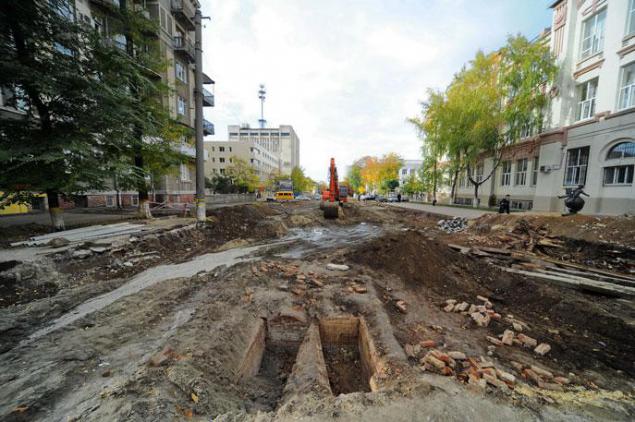
However, the first portion of the reconstruction was the old cemetery on the territory of Rostov, which all have forgotten. When workers for the first time stumbled upon human remains, they were alarmed and called the police. Law enforcement officials, convinced that this is a very old graves, and no crime here, lost to the human remains of any interest. A discovery of bones began to follow one after the other. On the walls of trenches dug for water main pipes, one could see a niche of the old graves, of which human bones sticking out.
And bucket, reveals a layer of asphalt, where the roadway took place, stumbled on a brick wall. At first glance, it was clear that it is facing two ancient crypts. When the top of the vaulted ceiling with a few bricks removed from the hole clearly drawn corruption. Work stopped at a place called the findings of scientists, archeologists.
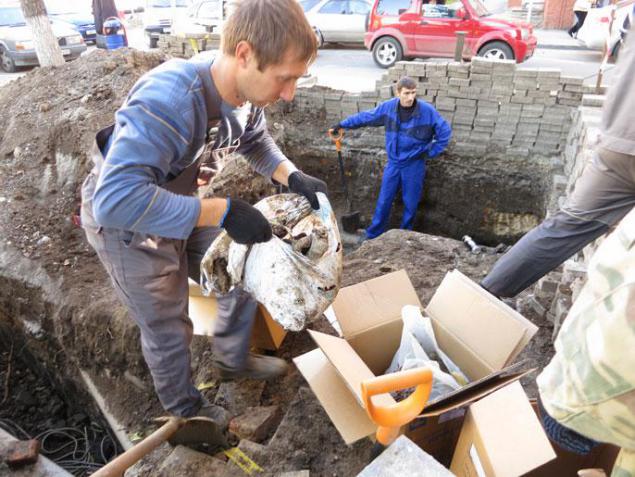
- Since the tombs could be the values I was in municipal government Interior Ministry, which is located just around the corner - the chairman of the Rostov branch of the Russian Society for Historic Preservation and Cultural Organization SA Kozhin. - On the intercom on duty described the situation and asked to allocate outfit patrol to guard the burial of the night to him under cover of darkness, vandals are not revealed.

One of the policemen, in the dark, began to shine a flashlight into the opening of the crypt. The beam of light was visible quite tselehonkim coffin studded with some colored border.

Unpleasant smell intensified and came to the public to watch it from the sidelines. One Mom hurried to withdraw their child, another woman aloud expressed fears that because of the opening of graves could spread any infection. Police wisely did not climb on the old grave, and covered the hole some cardboard. But the smell was still ...
Supervised work in opening the crypts and examination leading archaeologist public autonomous institution "Don heritage" Alexei Garmashov. One of the first working versions (before the opening of graves) was - that priests are buried here - the ministers of the Rostov church in the name of Stanislav, which before the revolution was built nearby, in the alley Cathedral. This is suggested by the form of burial: crypts characterized more Catholics than Orthodox. In any case, it was clear that there were buried not ordinary the Rostov, but rather clerics.
Assumption Church, standing on the Cathedral-Haymarket (destroyed in 1930) nearby on the site of the "House of professors" (Cathedral, 39) was once built the majestic church of the Assumption (demolished in the 30s of the last century). Around him, the cemetery was located. In the crypt could rest and priests of the temple.
However, a closer analysis of the historical finds, AI Garmashov put forward a completely different version. The fact is that the church and the Assumption Cathedral was built in the 80-ies of the XIX century, when the Hay Street already existed, although it was the outskirts of Rostov. Arrange the crypts under the feet of passers-by and the wheels of carts, of course, no one would. Consequently, disposal should be referred to an earlier period.
And before that next to this place was a church of All Saints. Her story began in 1785 when Dimitry fortress was decided to build a new, more spacious Protection Church. The old wooden church was dismantled and the materials were used to build a temple at the city cemetery, which was then at the intersection of the Catholic alley with current Chervonoarmiiska streets and the Greek city of Volos. The church was built very quickly, in just a year and a half, and May 19, 1787 Archpriest John was consecrated in the name of All Saints.
City cemetery was abolished at the beginning of the XIX century - the foreground of Rostov, it has been noted by a dotted line. City graveyard was moved to the west, in the new settlement (Now this place is the Palace of Sports). A Hay Street, as noted by AI Garmashov, the first urban plan although it was marked, but only as a promising, coming under the building. In fact, in those years, this area represented the grassy wasteland.
Much later the cemetery was demolished, it had been laid on Hay Street, in Soviet times, which received the name of Maxim Gorky. All Saints church burnt down as a result of the great fire of October 3, 1865. It was not restored, as at this time in a new city cemetery, at the expense of the mayor AM Baikov, was founded a new church, which became All Saints (blown up in 1966). A crypts, as well as other tombs of the old city cemetery, came under the feet of passers-by.
- Consequently, in these graves is likely to lie priests of ancient All Saints church. And they were buried not later 30-ies of the XVIII century - concludes on the basis of historical analysis conducted by a leading archaeologist "Don heritage" Alexei Ivanovich Garmashov.

Assumptions specialist practically fully confirmed the next day when the vaults were opened and both coffin. He attracted the attention of brick, from which were made vaults. Rough forms artisanal baking, no nameplate, which stands for their products Rostov brick factory owners. So, masonry vaults refers to an earlier time, when our city is still in its infancy.

The surprise caused the first coffin, which first saw the light after two centuries of stay in the crypt. Enough well-preserved wood was upholstered border, which on the lid formed an Orthodox cross.
As expected, in the grave will find the remains of the priest, at the opening of the crypt attended by a representative of the Don archdiocese.

With the help of a massive coffin learned the ropes on the ground. Immediately gently lifted the lid. Standing next to father constantly read prayers ...

Sunlight fell on the body of a man in the garb of a priest with a cross and charged. It was just the body (although mummified), and not decayed skeleton of what could be expected in an ancient tomb. Head up high lying on a pillow, folded his hands were clamped Orthodox cross. At the head of the deceased were even visible hair!
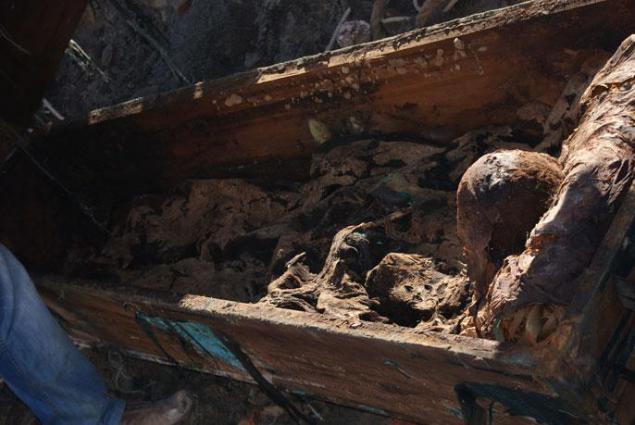
Similarly, the second and opened the coffin, too, perfectly preserved. But there were only bones. As the remnants of clothing found that there was a buried woman. According to initial assumptions, is the wife of the deceased priest, or someone of his relatives. It is highly likely that found the remains of one of the abbots of the church of All Saints.
When the coffin was lifted to the surface, the bottom completely rotted board fell off and the remains were left lying in the tomb.
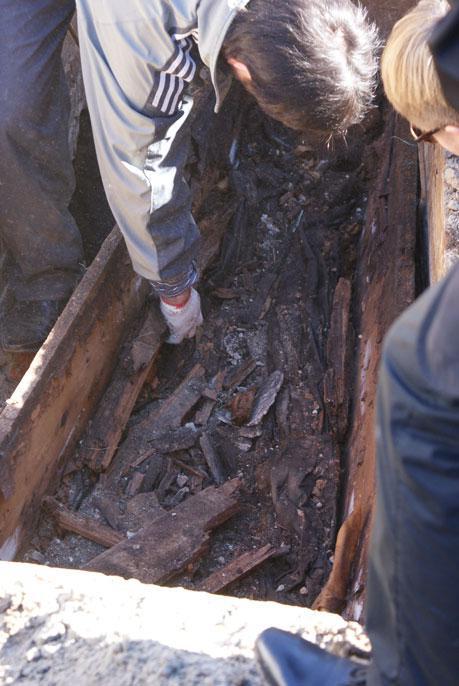
- In the church practice, such data allow us to raise the question of the identity of the deceased to the Commission on the canonization. Talking about clear evidence of holiness is premature, but the Commission for the Causes of the Rostov diocese started to investigate this case. Let's try to set the name of the priest, and at least some information about his life - made a comment, press secretary of the Archdiocese Don IP Petrovsky.
Church actively involved in the inspection of the excavated site of the old Orthodox cemetery. The remains of the tomb, as well as numerous fragments of bones from other graves, is now transferred to the church of the Holy Virgin that the Northern Cemetery.

- Sorry to identify the identity of all people have found impossible. But, given the place of burial, traditions and regulations of the time, we can determine with certainty, that it was a religious Orthodox Christians. Therefore, all the fragments of human remains found during road works are placed in a common container and are also sent to the Intercession Church. Our sacred duty, when reburial, not only to comply with due reverence, but also to make all these people first, probably for a few centuries, the funeral prayer, - says Igor Petrovsky.
Diocesan Commission for canonization has already begun its work. If the data is to be found and the reasons for the canonization, then Gorky Street was found not just an object of archaeological encumbrance, and miracle of God - said a spokesman for the Archdiocese Don.
It only remains to mention the panic rumors that last week have spread to Rostov. Say, from the ancient cemetery can crawl out of the city and spread any infection. Sanitary services of the city did not seem to notice opening the old graves ...

Source:
11 photos via news.rostov-today.ru

However, the first portion of the reconstruction was the old cemetery on the territory of Rostov, which all have forgotten. When workers for the first time stumbled upon human remains, they were alarmed and called the police. Law enforcement officials, convinced that this is a very old graves, and no crime here, lost to the human remains of any interest. A discovery of bones began to follow one after the other. On the walls of trenches dug for water main pipes, one could see a niche of the old graves, of which human bones sticking out.
And bucket, reveals a layer of asphalt, where the roadway took place, stumbled on a brick wall. At first glance, it was clear that it is facing two ancient crypts. When the top of the vaulted ceiling with a few bricks removed from the hole clearly drawn corruption. Work stopped at a place called the findings of scientists, archeologists.

- Since the tombs could be the values I was in municipal government Interior Ministry, which is located just around the corner - the chairman of the Rostov branch of the Russian Society for Historic Preservation and Cultural Organization SA Kozhin. - On the intercom on duty described the situation and asked to allocate outfit patrol to guard the burial of the night to him under cover of darkness, vandals are not revealed.

One of the policemen, in the dark, began to shine a flashlight into the opening of the crypt. The beam of light was visible quite tselehonkim coffin studded with some colored border.

Unpleasant smell intensified and came to the public to watch it from the sidelines. One Mom hurried to withdraw their child, another woman aloud expressed fears that because of the opening of graves could spread any infection. Police wisely did not climb on the old grave, and covered the hole some cardboard. But the smell was still ...
Supervised work in opening the crypts and examination leading archaeologist public autonomous institution "Don heritage" Alexei Garmashov. One of the first working versions (before the opening of graves) was - that priests are buried here - the ministers of the Rostov church in the name of Stanislav, which before the revolution was built nearby, in the alley Cathedral. This is suggested by the form of burial: crypts characterized more Catholics than Orthodox. In any case, it was clear that there were buried not ordinary the Rostov, but rather clerics.
Assumption Church, standing on the Cathedral-Haymarket (destroyed in 1930) nearby on the site of the "House of professors" (Cathedral, 39) was once built the majestic church of the Assumption (demolished in the 30s of the last century). Around him, the cemetery was located. In the crypt could rest and priests of the temple.
However, a closer analysis of the historical finds, AI Garmashov put forward a completely different version. The fact is that the church and the Assumption Cathedral was built in the 80-ies of the XIX century, when the Hay Street already existed, although it was the outskirts of Rostov. Arrange the crypts under the feet of passers-by and the wheels of carts, of course, no one would. Consequently, disposal should be referred to an earlier period.
And before that next to this place was a church of All Saints. Her story began in 1785 when Dimitry fortress was decided to build a new, more spacious Protection Church. The old wooden church was dismantled and the materials were used to build a temple at the city cemetery, which was then at the intersection of the Catholic alley with current Chervonoarmiiska streets and the Greek city of Volos. The church was built very quickly, in just a year and a half, and May 19, 1787 Archpriest John was consecrated in the name of All Saints.
City cemetery was abolished at the beginning of the XIX century - the foreground of Rostov, it has been noted by a dotted line. City graveyard was moved to the west, in the new settlement (Now this place is the Palace of Sports). A Hay Street, as noted by AI Garmashov, the first urban plan although it was marked, but only as a promising, coming under the building. In fact, in those years, this area represented the grassy wasteland.
Much later the cemetery was demolished, it had been laid on Hay Street, in Soviet times, which received the name of Maxim Gorky. All Saints church burnt down as a result of the great fire of October 3, 1865. It was not restored, as at this time in a new city cemetery, at the expense of the mayor AM Baikov, was founded a new church, which became All Saints (blown up in 1966). A crypts, as well as other tombs of the old city cemetery, came under the feet of passers-by.
- Consequently, in these graves is likely to lie priests of ancient All Saints church. And they were buried not later 30-ies of the XVIII century - concludes on the basis of historical analysis conducted by a leading archaeologist "Don heritage" Alexei Ivanovich Garmashov.

Assumptions specialist practically fully confirmed the next day when the vaults were opened and both coffin. He attracted the attention of brick, from which were made vaults. Rough forms artisanal baking, no nameplate, which stands for their products Rostov brick factory owners. So, masonry vaults refers to an earlier time, when our city is still in its infancy.

The surprise caused the first coffin, which first saw the light after two centuries of stay in the crypt. Enough well-preserved wood was upholstered border, which on the lid formed an Orthodox cross.
As expected, in the grave will find the remains of the priest, at the opening of the crypt attended by a representative of the Don archdiocese.

With the help of a massive coffin learned the ropes on the ground. Immediately gently lifted the lid. Standing next to father constantly read prayers ...

Sunlight fell on the body of a man in the garb of a priest with a cross and charged. It was just the body (although mummified), and not decayed skeleton of what could be expected in an ancient tomb. Head up high lying on a pillow, folded his hands were clamped Orthodox cross. At the head of the deceased were even visible hair!

Similarly, the second and opened the coffin, too, perfectly preserved. But there were only bones. As the remnants of clothing found that there was a buried woman. According to initial assumptions, is the wife of the deceased priest, or someone of his relatives. It is highly likely that found the remains of one of the abbots of the church of All Saints.
When the coffin was lifted to the surface, the bottom completely rotted board fell off and the remains were left lying in the tomb.

- In the church practice, such data allow us to raise the question of the identity of the deceased to the Commission on the canonization. Talking about clear evidence of holiness is premature, but the Commission for the Causes of the Rostov diocese started to investigate this case. Let's try to set the name of the priest, and at least some information about his life - made a comment, press secretary of the Archdiocese Don IP Petrovsky.
Church actively involved in the inspection of the excavated site of the old Orthodox cemetery. The remains of the tomb, as well as numerous fragments of bones from other graves, is now transferred to the church of the Holy Virgin that the Northern Cemetery.

- Sorry to identify the identity of all people have found impossible. But, given the place of burial, traditions and regulations of the time, we can determine with certainty, that it was a religious Orthodox Christians. Therefore, all the fragments of human remains found during road works are placed in a common container and are also sent to the Intercession Church. Our sacred duty, when reburial, not only to comply with due reverence, but also to make all these people first, probably for a few centuries, the funeral prayer, - says Igor Petrovsky.
Diocesan Commission for canonization has already begun its work. If the data is to be found and the reasons for the canonization, then Gorky Street was found not just an object of archaeological encumbrance, and miracle of God - said a spokesman for the Archdiocese Don.
It only remains to mention the panic rumors that last week have spread to Rostov. Say, from the ancient cemetery can crawl out of the city and spread any infection. Sanitary services of the city did not seem to notice opening the old graves ...

Source:



